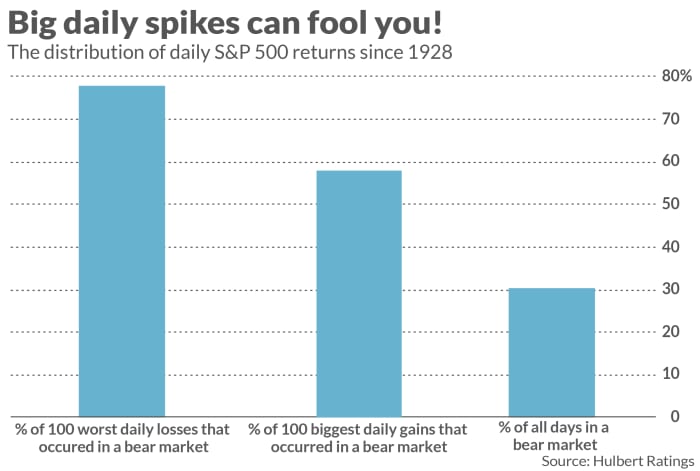This post was originally published on this site
Bear markets like to trick you into thinking they have come to an end.
They do that by mounting explosive one-day rallies. Those jumps more often than not turn out to be traps that lure the gullible back into the market just as it’s about to turn down again. Bear markets constantly are playing Lucy to investors’ Charlie Brown, promising not to yank the football away just when you’re about to kick it—and then doing exactly that.
Read: S&P 500 falls into bear-market territory
This buy-high sell-low behavior is why many investors perform even worse than index funds during major declines. Today, given that the major market averages are in danger of slipping into official bear-market territory, it’s more important than ever to understand this mischievous behavior from Mr. Market.
Consider the 100 best one-day rallies mounted by the S&P 500
SPX,
since 1928. You would be excused for thinking that such rallies are most likely to occur during bull markets. Alternately, you might believe that such rallies occur randomly across both bull and bear markets alike. The last thing you’d suspect is that these big one-day rallies are more likely to occur during bear markets.
Yet that’s precisely the case.
To appreciate what my analysis found, bear in mind that 30.3% of the trading days since 1928 have occurred during a bear market in the calendar maintained by Ned Davis Research. So if the 100 best one-day rallies were more likely to occur during bull markets, you’d expect fewer than 30 of them to occur when the major trend was down. In fact, however, 58 of those 100 biggest one-day rallies occurred during bear markets, as you can see from the accompanying chart. In other words, the probability that a big one-day rally occurs during a bear market is nearly twice as high as you’d expect on the basis of randomness.

Furthermore, as the chart also shows, the probability of a big daily jump occurring during a bear market is almost as high as the probability of a big daily plunge.
Nasdaq
I was prompted to conduct this analysis by a fascinating report from Cornell Capital into the bear market concentration of the biggest rallies in the Nasdaq Composite index
COMP,
That concentration is even more pronounced than it is for the S&P 500.
What Cornell Capital did was focus on just the last three bear markets: The 2000-2002 bursting of the Internet bubble, the 2007-2009 global financial crisis, and the bear market in early 2020 that accompanied the onset of the COVID-19 pandemic. Of all trading days since the Nasdaq Composite index was created in 1971, just 7.8% took place during one of these three bear markets.
Nevertheless, an incredible 80% of the forty biggest one-day rallies in the Nasdaq Composite occurred during one of these three bear markets. That’s nearly 10 times the percentage you’d expect if those rallies occurred randomly.
The investment implication? Big daily rallies stock market often don’t mean what you think they do. So don’t base any major changes in your portfolio on those rallies.
Mark Hulbert is a regular contributor to MarketWatch. His Hulbert Ratings tracks investment newsletters that pay a flat fee to be audited. He can be reached at mark@hulbertratings.com



